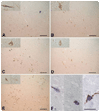Narcolepsy: immunological aspects
- PMID: 18291691
- PMCID: PMC2366136
- DOI: 10.1016/j.smrv.2007.07.010
Narcolepsy: immunological aspects
Abstract
Narcolepsy with cataplexy is a debilitating sleep disorder with an estimated prevalence of about 0.05%. Narcolepsy is caused by a selective loss of hypocretin (orexin) producing neurons in the perifornical hypothalamus. Based on the very strong association with the HLA subtype DQB1*0602, it is currently hypothesized narcolepsy is caused by an autoimmune-mediated process directed at the hypocretin neurons. So far however, studies focusing on general markers of (auto)immune activation, as well as humoral immunity against the hypocretin system have not yielded consistent results supporting this hypothesis.
Figures




References
-
- Overeem S, Mignot E, van Dijk JG, Lammers GJ. Narcolepsy: clinical features, new pathophysiologic insights, and future perspectives. J Clin Neurophysiol. 2001;18:78–105. - PubMed
-
- Douglas NJ. The psychosocial aspects of narcolepsy. Neurology. 1998;50:S27–S30. - PubMed
-
- Broughton WA, Broughton RJ. Psychosocial impact of narcolepsy. Sleep. 1994;17:S45–S49. - PubMed
-
- ICSD. International Classification of Sleep Disorders. Second Edition. Westchester, Il: American Academy of Sleep Medicin; 2005.
-
- Broughton R, Krupa S, Boucher B, et al. Impaired circadian waking arousal in narcolepsy-cataplexy. Sleep Res Online. 1998;1:159–165. - PubMed
Publication types
MeSH terms
Substances
Grants and funding
LinkOut - more resources
Full Text Sources
Research Materials

